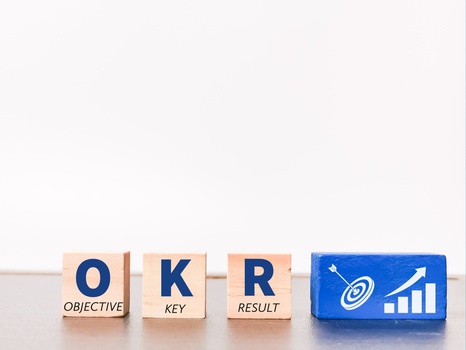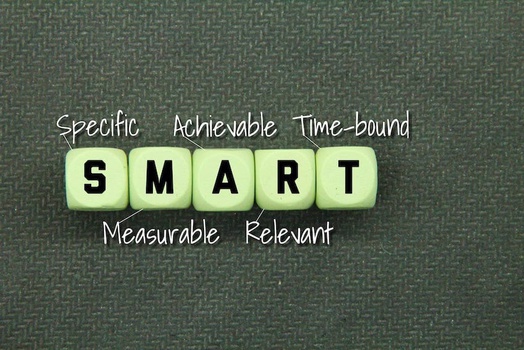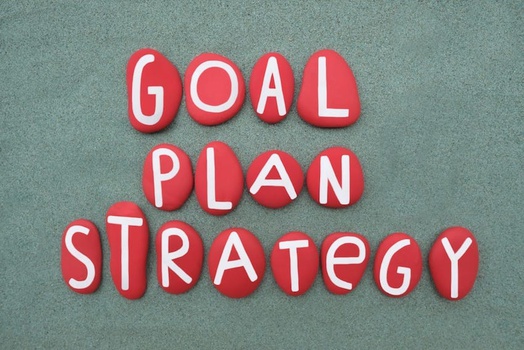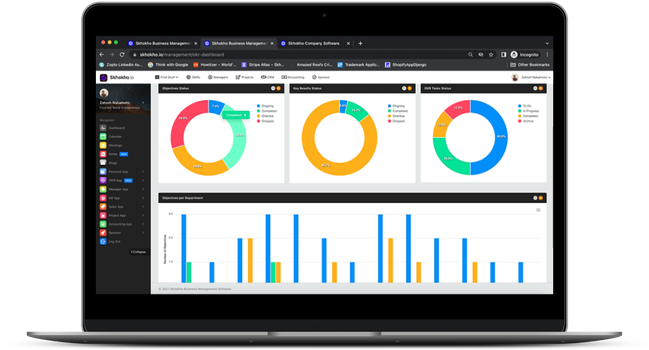50+ OKR examples - How To Write Effective OKRs in 2022
In this article, we'll give an overview of the use of OKRs and provide some good OKR examples from different organizations. We'll also discuss some tips for creating effective and good OKRs.

There are a lot of different options for setting objectives, but OKRs are often seen as a popular and effective way to measure progress.
OKRs can be implemented in a variety of ways, but it's important to make sure they fit the culture and values of your business. It's also important to make sure all employees are on board with the objectives, as it can be difficult to change them if they're not successful.
What are OKRs?
Objective Key Results (OKRs) are a framework for setting measurable goals and tracking progress. They are often used in business and can be adapted for use in other areas, such as personal development.
The key components of an OKR are objectives, which are specific goals that need to be achieved, and key results, which are the metrics used to measure progress towards the objectives.

Setting OKRs can help to focus and align team members towards a common goal, and tracking progress can help to identify areas where improvements need to be made.
Origins of Objective Key Results(OKRs)
The OKR framework was developed in the 1960s by Andy Grove for Intel. The framework does not aim to help determine your overall vision for the business, but to help develop a high-level vision to achieve organizational success.
How do OKRs work?
OKRs include two components: objectives and key results. It is your goal. It is not primarily a numerical or quantitative goal but generally reflects a high-level aspiration which starts with verbal words like: Key outcomes of teams.
OKR is where you get the details. How can we achieve our OKR goals in a short period of time? Listed below are examples for OKR that can help you get a better understanding of the process.
Setting OKRs from the top down
When setting OKRs, one should start at the top of the organisation and work down from there until they cover the entire organization. High level corporate OKRs should be designed to align the company’s overall objectives with those of its individual departments and team okrs.
The top-down approach to setting OKRs helps to ensure that all departments are held accountable for achieving the company’s objectives.
By setting OKRs at the top of the organisation, managers can ensure that all employees are aware of and understand the company’s overall goals, and that they are working towards the same objectives.
This approach also helps to ensure that the company’s resources are being put to best use, and that all employees are working towards a common goal.
How to write Effective OKRs in 2022
When developing OKRs, it is essential to consider the following points:
1. Objectives should be specific, measurable, achievable, relevant and time-bound (SMART)

2. Objectives should be aligned with the company's strategy
3. Key results should be quantifiable
4. Objectives and key results should be reviewed and updated on a regular basis
You can note that an objective can be 3 to 6 team, business or personal goals. The objective should also have 3 to 5 key results which explain how the goal will be measured and when it should be achieved.
Defining Great Objectives for OKRs
If you're looking to implement OKRs in your organization, it's important to first define what your objectives are. What are you hoping to achieve with this system? Do you want to increase productivity? Drive innovation? Encourage better communication?
Once you have a good understanding of your goals, you can start to develop specific OKRs. For individuals (individual OKRs), this might mean setting objectives that align with their role in the company (company OKRs).

For example, a salesperson might set an objective to increase sales by 10% over the next quarter. For a company, objectives might be more broad, such as increasing market share or developing a new product.
It's also important to keep your objectives realistic. Trying to achieve too much in a short period of time can lead to frustration and burnout. When setting OKRs, it's important to consider what is actually achievable given your resources and timeframe.
If you're not sure where to start, there are plenty of OKR examples out there. Doing a quick search online will provide you with a variety of options to choose from. You can also find OKR templates that can help you get started. Once you have a good understanding of how OKRs work, you can start to develop your own unique system that meets the needs of your organization.
We will cover OKR examples in this blog, to cover both individual level OKR examples and company level OKR examples using best practices in OKR methodology.
Which Companies are using OKRs?
Some of the biggest and most successful companies in the world are using OKRs to help them achieve their desired outcomes. Google, for example, is one of the most well-known companies to use OKRs. Other notable companies include Intel, LinkedIn, Twitter, and Spotify.
There are a few things that all of these companies have in common when it comes to their OKRs. First, they all have a clear and concise strategic plan. They know exactly what they want to achieve and they have a specific timeline for doing so.

Second, they all involve their entire company in the process. Everyone from the CEO to the entry-level employees knows what the company's OKRs are and they all play a role in achieving them.
Finally, these companies all have a dedicated team that is responsible for setting, tracking, and achieving the OKRs. This team is typically made up of executives and other high-level employees. They meet regularly to review progress and make necessary adjustments.
If your company is thinking about implementing OKRs, then these are some of the best examples to look for inspiration.
Real Life OKR examples used by actual companies
Google Team OKRs Examples
Objective: Improve search quality
Key Results:
-Reduce the percentage of searches that return no results
-Reduce the percentage of searches that return results that don't match the user's query
-Increase the number of searches that return results that match the user's query
Intel Team OKRs Examples
Objective: Be the preferred choice for microprocessors
Key Results:
-Grow revenue from microprocessors
-Grow market share for microprocessors
-Grow customer satisfaction for microprocessors
Company OKR examples
In this section we will present some company and team OKRs for your business, these are guidelines only and in some cases we have imagines fictitious companies to create objectives and key results for.
Use these OKR examples to guide you to develop your own team OKRs that fit your business model and objective in order to help you achieve your company goals.

Customer Delivery OKRs Examples
Imagine you are a grocery delivery app and you want to improve your service level and customers key results.
In order to cover Customer Key Results to deliver customer success, consider the following OKR examples:
OKR examples : Objective 1
To ensure that our customers have a great experience when using our grocery delivery app, we will track customer satisfaction rates and work to improve them over time.
Key Result 1: Customer satisfaction rates with the grocery delivery app increase by X% over time.
Key Result 2: The number of customer complaints about the grocery delivery app decreases by X% over time.
Key Result 3: The number of customers who use the grocery delivery app on a regular basis increases by X% over time.
OKR examples : Objective 2
To ensure that our customers receive their groceries in a timely manner, we will track delivery times and work to improve them over time.
Key Result 1: The average delivery time for groceries decreases by X% over time.
Key Result 2: The number of customer complaints about late deliveries decreases by X% over time.
Key Result 3: The number of customers who receive their groceries within the expected delivery time increases by X% over time.
OKR examples : Objective 3
To ensure that our customers are able to find the groceries they need on our app, we will track the number of items in stock and work to improve it over time.
Key Result 1: The number of items in stock on the grocery delivery app increases by X% over time.
Key Result 2: The number of customer complaints about items being out of stock decreases by X% over time.
Key Result 3: The number of customers who are able to find the items they need on the grocery delivery app increases by X% over time.
Operational Excellence OKRs examples
Here are some operational excellence OKR examples:

Objective 1 - Increasing Customer Satisfaction by 30% by December 2022
1.1. Key Result - Increase customer survey scores by 30%
1.2. Key Result - Increase customer retention rate by 5%
1.3. Key Result - Decrease customer complaints by 10%
Objective 2 - Increasing Production Rates and Efficiencies by 10% by December 2022
2.1. Key Result - Increase production output by 10%
2.2. Key Result - Decrease production downtime by 5%
2.3. Key Result - Increase production line efficiency by 5%
Objective 3 - Cutting Operating Costs to a Minimum by 10% by December 2022
3.1. Key Result - Decrease direct operating costs by 10%
3.2. Key Result - Decrease indirect operating costs by 10%
3.3. Key Result - Decrease energy consumption by 10%
Product Marketing OKR Examples
Objectives: Creating the greatest client-audit board experience Key Results: Objectives: Gain strong customer awareness by listening / understanding the voice of the customer for retention Key Results: Objective - Boost customer engagement program Key Results: Free 15 days trial Easy to use!
1. Objective: Gain customer awareness by listening and understanding the voice of the customer
1.1 Key Result: Our team will research and compile at least 10 customer testimonials
1.2 Key Result: Our team will host at least 5 customer focus groups
1.3 Key Result: Our team will survey at least 500 customers
2. Objective: Boost customer engagement with our product
2.1 Key Result: Our team will create at least 3 new pieces of content per week
2.2 Key Result: Our team will launch at least 2 new marketing campaigns
2.3 Key Result: Our team will host at least 1 webinar per month
3. Objective: Improve marketing efforts this financial year
3.1 Key Result: Our team will increase website traffic by at least 10%
3.2 Key Result: Our team will increase conversion rates by at least 15%
3.3 Key Result: Our team will increase social media engagement by at least 20%
OKR examples for product/engineering team
1. Objective: To promote innovation by creating new products that solve customer problems
1.1 Key Result: Research and develop at least 2 new products that solve customer problems
1.2 Key Result: submit at least 3 patents for new products
1.3 Key Result: receive feedback from at least 100 customers on new products
2. Objective: To fix bugs and problems with existing products
2.1 Key Result: Resolve at least 50% of all customer complaints
2.2 Key Result: Test and launch at least 2 new product updates
2.3 Key Result: Improve customer satisfaction ratings by at least 5%
3. Objective: To improve the UI and improve customer retention
3.1 Key Result: redesign at least 3 pages of the UI
3.2 Key Result: A/B test at least 2 new UI features
3.3 Key Result: Increase customer retention by at least 3%
Sales OKR examples

1. Objective: Increase monthly sales revenue
1.1 Key Results: increase Monthly Recurring Revenue by 10%
1.2 Key Results: increase the number of new customers by 20%
1.3 Key Results: increase customer retention by 5%
2. Objective: Improve on the number and quality of products demos to clients
2.1 Key Results: increase the number of demos by 25%
2.2 Key Results: increase the number of qualified leads by 30%
2.3 Key Results: increase the number of conversions by 10%
3. Objective: Increase the number of monthly sales leads
3.1 Key Results: increase the number of sales leads by 20%
3.2 Key Results: increase the number of meetings set up with sales leads by 30%
3.3 Key Results: increase the number of sales closed by 10%
OKR Examples for Business Operations Managers
Objective: Create and implement a communication plan that encourages team collaboration and alignment across departments.
Key Results:
-Achieve a 75% satisfaction score on the company's employee satisfaction survey for employees who feel their team communicates effectively.
-Increase the number of company-wide meetings by 20%.
-Set and track team objectives and key results on a regular basis.
Objective: Develop and implement a system for setting, measuring and tracking OKRs.
Key Results:
-Set OKRs for 100% of employees.
-Measure and track OKRs on a monthly basis.
-Achieve a 90% satisfaction score on the company's employee satisfaction survey for employees who feel their OKRs are being tracked effectively.
Objective: Streamline business processes to increase operational efficiency.
Key Results:
-Achieve a 30% reduction in the average time it takes to complete a task.
-Achieve a 20% reduction in the number of errors made during task completion.
-Achieve a 75% satisfaction score on the company's employee satisfaction survey for employees who feel their job is efficient.
HR OKR examples
Objective: Increase employee engagement
Key Results: Employee satisfaction score increases by X%
Key Results: Employee engagement score increases by X%
Key Results: Turnover decreases by X%
Objective: Create, measure, and track employee key results
Key Results: % of employees with updated key results increases by X%
Key Results: % of employees meeting key results increases by X%
Key Results: % of employees exceeding key results increases by X%
Objective: Decrease new employee turnover
Key Results: % of new employees still employed after X months increases by X%
Key Results: % of new employees engaged after X months increases by X%
Key Results: % of new employees who say they would recommend the company to others increases by X%
Quality Assurance Department OKR examples

1. Objective: To ensure that there are standard operating procedures and processes for every department in the company.
1.1 Key Results: Conduct a review of all departmental procedures and processes.
1.2 Key Results: Develop and implement standard operating procedures and processes for all departments.
1.3 Key Results: Evaluate compliance of all departments with standard operating procedures and processes.
2. Objective: To ensure that products and services meet the established standards set by the company.
2.1 Key Results: Conduct a review of all products and services.
2.2 Key Results: Establish standards for all products and services.
2.3 Key Results: Evaluate compliance of all products and services with established standards.
3. Objective: To ensure that the company adheres to reliability, performance and customer expectations.
3.1 Key Results: Conduct a review of all company procedures and processes.
3.2 Key Results: Establish standards for all company procedures and processes.
3.3 Key Results: Evaluate compliance of the company with established standards.
Annual company-level OKR examples
Objective: Increase market share in Latin America by 15%
Key Results:
1. Increase online visibility in Latin America by 20%
2. Generate leads from Latin American customers by 10%
3. Increase sales to Latin American customers by 15%
Objective: Reduce operating costs for various departments by 8%
Key Results:
1. Reduce inventory costs by 10%
2. Reduce labor costs by 5%
3. Reduce materials costs by 8%
Objective: Increase the company growth rate to 12% year on year Key Results:
1. Increase revenue by 12%
2. Increase number of customers by 10%
3. Increase number of new products by 8%
Finance Department OKR examples
1. Objective: To ensure that the company adheres to the set budgets in various departments
1.1. Key result: All departments stay within their allocated budget
1.2. Key result: The company budgetary system is updated and streamlined
1.3. Key result: All employees are aware of and adhere to the company budget policy
2. Objective: To reduce working capital and days sales outstanding
2.1. Key result: Negotiate more favorable payment terms with suppliers
2.2. Key result: Streamline and automate accounts payable process
2.3. Key result: Review inventory levels and adjust reorder points as needed
3. Objective: To maintain accurate record keeping, passing all required financial audits
3.1. Key result: All financial records are up to date and accurate
3.2. Key result: The company passes all financial audits
3.3. Key result: All employees receive training on proper financial record keeping
Business Development/sales team OKR examples
1. Objective: Increase Units Sold and Boost Profit Margins in the sales team
1.1 Key Result: Increase the number of units sold by 10%
1.2 Key Result: Boost profit margins by 2%
1.3 Key Result: Increase customer satisfaction ratings by 5%

2. Objective: Increase Win Rates and improve sales pipeline
2.1 Key Result: Increase win rates by 15%
2.2 Key Result: Reduce the number of days it takes to close a deal by 10%
2.3 Key Result: Increase the number of qualified leads in the sales pipeline by 20%
3. Objective: Lower Customer Acquisition Costs in the sales process and sales cycle
3.1 Key Result: Decrease customer acquisition costs by 10%
3.2 Key Result: Decrease the number of days it takes to sign a new customer by 15%
3.3 Key Result: Increase the number of customers acquired through referrals by 20%
Get Started with Skhokho OKRs
Skhokho OKR app offers a complete tool to help your organisation: (1) define, (2) record, (3) measure and track individual OKRs, team OKRs, departmental OKRs and Company OKRs.

Start by creating a 14 day free account here: https://skhokho.io/authentication/register
Navigate to the OKR app and start by entering an objective, once you have completed entering an objective -- you will have an opportunity to create multiple Key Results to support that objective.









